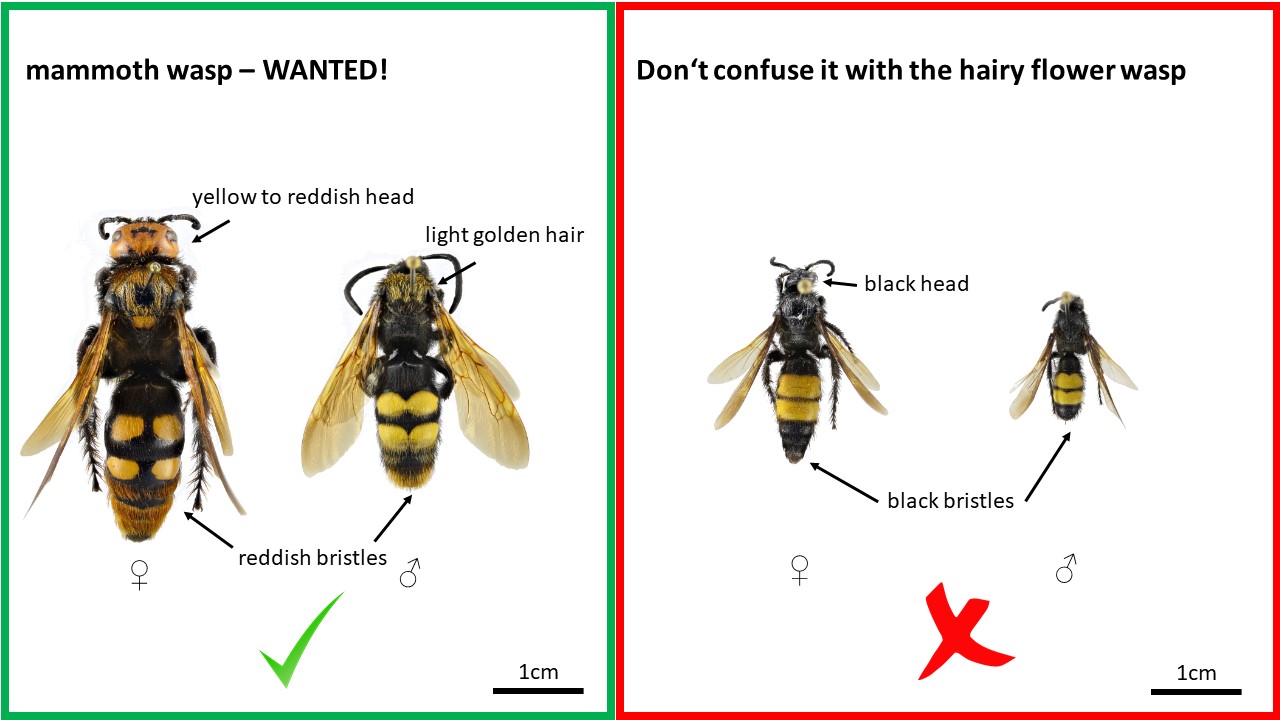Mammoth wasp
The mammoth wasp Megascolia maculate is the largest wasp species in Europe with a body length of up to 4.5 cm. In Austria, a few specimens of the mediterranean species were found in Vienna and Lower Austria at the end of the 19th century. Since then, there have been sporadic sightings in eastern Austria in recent years. Due to the current climatic warming it can be assumed that the species will spread further in Austria in the next years. In order to observe and document this, we need your help.
As the species is still very rare in Austria and the flight time is very short, it is almost impossible to find it by active search, let alone to get an overview of the current occurrences in Austria. However, if many people keep their eyes open and observe the activity in their surroundings, success is certain, because the wasp is hard to miss!
The wasps hatch in our latitudes in June and can be observed until about mid-July. The adults feed on nectar and visit preferably blue and reddish-blue flowers from various families, such as the genus Allium, Eryngium or thistles, when foraging; they have also been observed on the common silk plant. The males, which usually hatch a week earlier, fly in search of females at a height of 50 to 150cm. The females mate fairly soon after their appearance and then search for a suitable host for oviposition: grubs of rhinoceros beetles, stag beetles, or walkers are accepted. The larvae of the mammoth wasp grow throughout the summer and then overwinter as a pupa in a cocoon, from which an adult wasp hatches again in the following early summer.
Observations are mostly made while nectar-feeding on flowers. In Austria, the species has so far been observed on the common milkweed, hollyhock, lavender and leek. Since the beginning of the citizen science project, the red-fronted dagger wasp has already been documented at 12 sites in northeastern Austria. The westernmost sites so far are Mistelbach and Strasshof an der March.
Recognition of the mammoth wasp
Besides its considerable size of up to 4.5cm body length, the most striking features of the mainly black and bristly-haired wasp are the yellow, orange-red or red colored head with large mandibles and the yellow spots on the abdomen. The posterior part of the abdomen is covered with reddish bristles.
Attention! There is a risk of confusion with another, smaller species, which is commonly found in our area: The hairy flower wasp (Scolia hirta) has yellow spots on the abdomen as well, but a black colored head!

© Harald Schillhammer
Sighting reports
Sightings of the mammoth wasp with photo, date and exact location can be reported by email to This email address is being protected from spambots. You need JavaScript enabled to view it.. Furthermore, information on the plant species is also interesting if the wasp was observed visiting flowers.
The corresponding sighting data will be evaluated and published afterwards.
You will receive a confirmation or correction of your identification and if you wish, you will be mentioned by name in the article. The scientific publication will be sent to all who have contributed with their data.
Project goals
The aim of the project is to monitor the spread of the mammoth wasp Megascolia maculata in Austria using data submitted by Citizen Scientists. As in several other species, changes in the distribution are related to the climatic warming. If sufficient data are acquired, the diving factors in this process will also be scientifically analyzed.
In addition, the project aims to increase awareness of the native insect fauna and its dynamics. Observing and recognizing the largest wasp in Europe can also be an impressing experience.
Gallery
-
 Mammoth wasp in Austria © Franz Wieland Mammoth wasp in Austria © Franz Wieland
Mammoth wasp in Austria © Franz Wieland Mammoth wasp in Austria © Franz Wieland -
 Mammoth wasp on Common silk plant in Austria © Günter Gaß Mammoth wasp on Common silk plant in Austria © Günter Gaß
Mammoth wasp on Common silk plant in Austria © Günter Gaß Mammoth wasp on Common silk plant in Austria © Günter Gaß -
 Mammoth wasp on redcurrant in Austria © Gerhard Barisch Mammoth wasp on redcurrant in Austria © Gerhard Barisch
Mammoth wasp on redcurrant in Austria © Gerhard Barisch Mammoth wasp on redcurrant in Austria © Gerhard Barisch -
 Mammoth wasp in Austria © Gerhard Barisch Mammoth wasp in Austria © Gerhard Barisch
Mammoth wasp in Austria © Gerhard Barisch Mammoth wasp in Austria © Gerhard Barisch
https://www.citizen-science.at/en/projects/mammoth-wasp#sigProId90fbf13b10
Project institution
This project fulfils version 1.1 of the quality criteria for citizen science projects on Österreich forscht.
- animals


